- AI Fire
- Posts
- 🔑 The AI Secret To Reports That Clients Actually Implement
🔑 The AI Secret To Reports That Clients Actually Implement
Don't just write reports, drive results. This guide shows how to blend McKinsey's methods with AI to turn insights into action clients will implement.
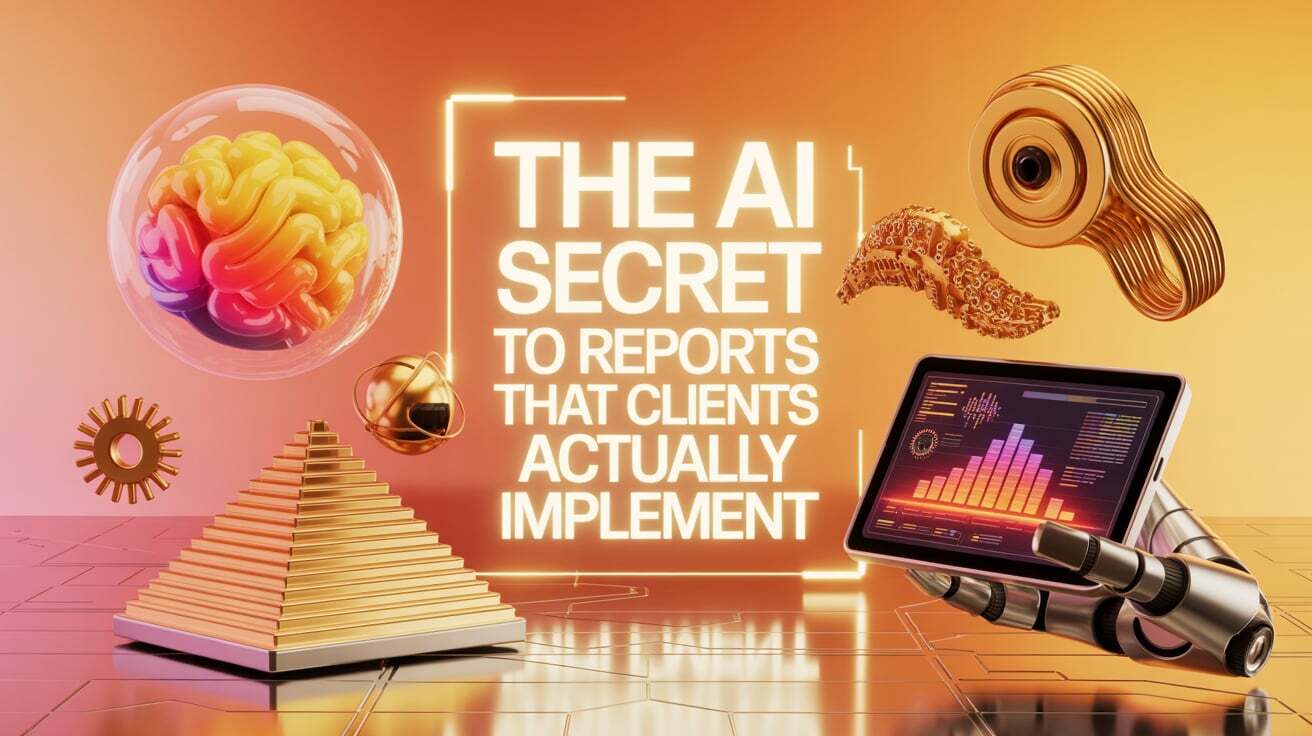
What is the single biggest challenge you face in your consulting or advisory work? |
Table of Contents
In the digital age, consultants face a paradox: we have access to a myriad of powerful artificial intelligence (AI) tools capable of processing data and generating insights at an unprecedented scale, yet the core challenge of the industry remains unchanged. That challenge isn't keeping up with the latest technology, but a much older and more elusive problem: how to persuade clients to actually act on your recommendations.
You can spend weeks building a complex AI analysis, generating a stunningly comprehensive report, or designing a brilliant, innovative solution. But if those efforts only lead to an appreciative nod in the boardroom before being filed away, the real value delivered is almost zero. When clients don't implement, they don't see results. And when they don't see results, contract renewal becomes highly uncertain.
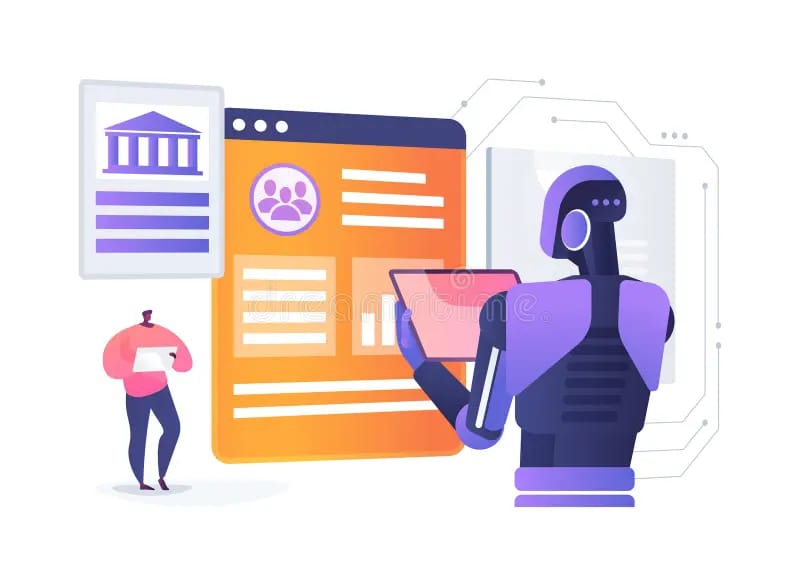
This frustrating cycle is all too familiar to many consultants:
You deliver profound, AI-backed technical analysis.
Clients seem impressed during presentations.
However, nothing changes in their organization's operations.
The conversation about contract renewal becomes awkward and uncertain.
The solution to this perennial problem lies not in finding a more powerful AI tool, but in how we structure and present our findings. By combining classic, time-tested consulting methodologies with the power of modern AI, we can create reports that not only inform but also inspire and drive action.
The Pyramid Principle: The Gold Standard For Persuasive Communication
Before diving into AI tools, we must return to a fundamental principle that has shaped the consulting industry for decades: The Pyramid Principle. Developed by Barbara Minto, the first female consultant at McKinsey & Company, this method is the gold standard for effective business communication.
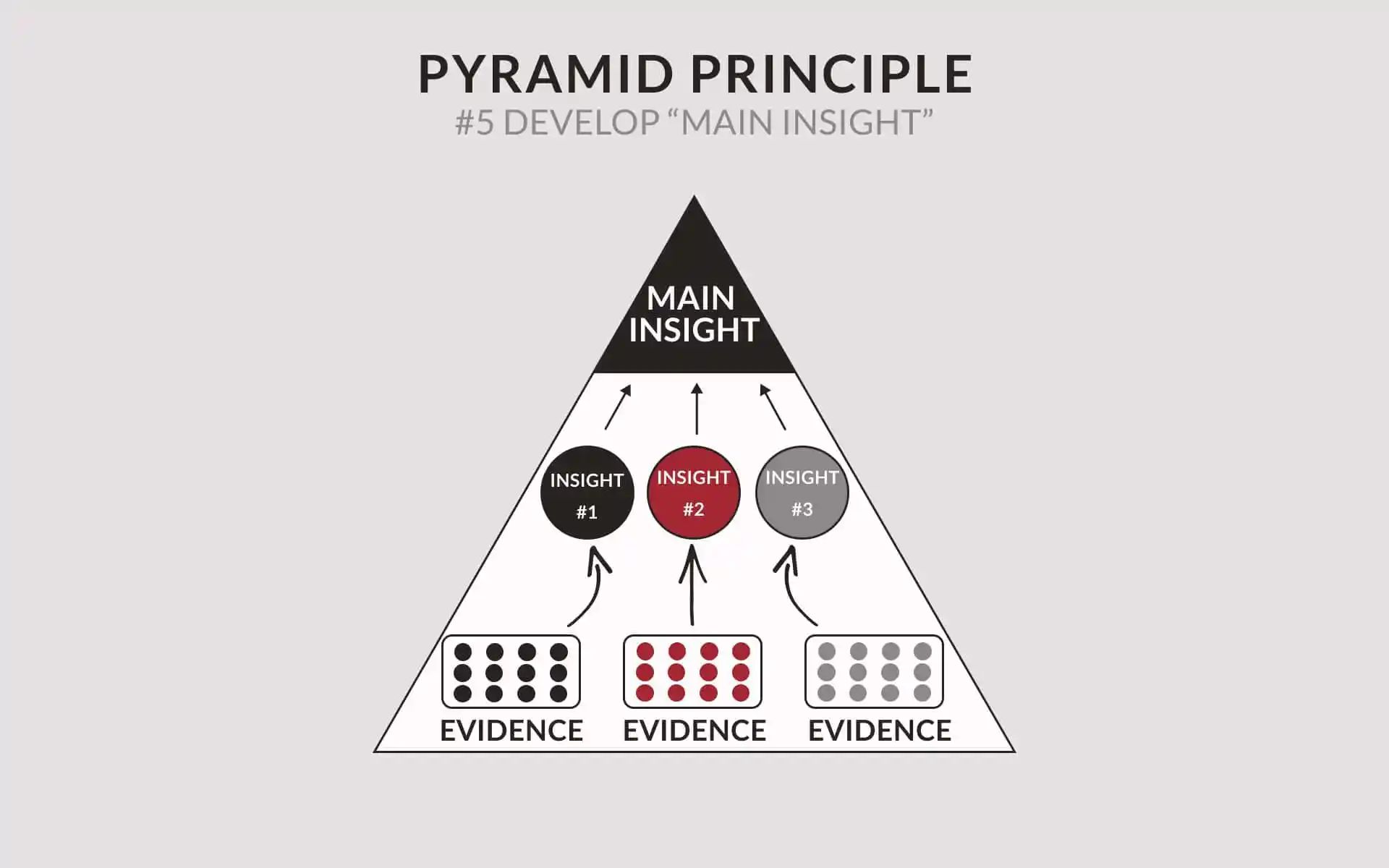
Contrary to traditional academic writing where the conclusion is saved for the end, the Pyramid Principle inverts that structure entirely:
Start with the Answer: Present your main conclusion or recommendation right at the beginning. This is the core message you want your audience to remember.
Support with Key Arguments: Back up your answer with 3-4 strong, key arguments. Each of these arguments should be a distinct idea that directly supports the main conclusion.
Provide Evidence and Data: Underneath each argument, provide the specific data, evidence, examples, and analysis to prove its validity.
The structure looks like a pyramid:
/ \
/ \ <-- The Main Conclusion (The Answer)
/-----\
/ | | \
/ | | \ <-- Argument 1 | Argument 2 | Argument 3
/ | | \
/----|---|----\
/| \ /| \ /| \
/ | \/ | \/ | \ <-- Supporting Data & Evidence for each argument
/__|__\/__|__\/__|\
The beauty of this approach lies in its cognitive efficiency. Busy executives can grasp your main point in the first 30 seconds. If they are convinced or want to learn more, they can travel down the pyramid's layers to examine the detailed arguments and evidence. This method respects their time and aligns with how the brain makes decisions: grasp the big idea first, then seek validation.
Now, let's explore how AI can supercharge every step of this process, turning it into a highly effective system for creating impactful consulting reports.
Learn How to Make AI Work For You!
Transform your AI skills with the AI Fire Academy Premium Plan - FREE for 14 days! Gain instant access to 500+ AI workflows, advanced tutorials, exclusive case studies and unbeatable discounts. No risks, cancel anytime.
The 5-Stage AI-Enhanced System
This system breaks down the process from raw research to the final presentation into five distinct stages, each optimized with specific AI tools.
Stage 1: Foundation – AI-Powered Intelligence Gathering
Every great report begins with a solid research foundation. However, simply asking an AI to "research [topic]" will yield generic results. The key to deep research is a technique called "meta-prompting."
Step 1: Create a Meta-Prompt
Instead of writing a research prompt directly, you first create a prompt for the AI to help you build a more detailed research prompt. This forces you to clearly define your objective, audience, and desired outcome before you begin.
New Meta-Prompt Example:
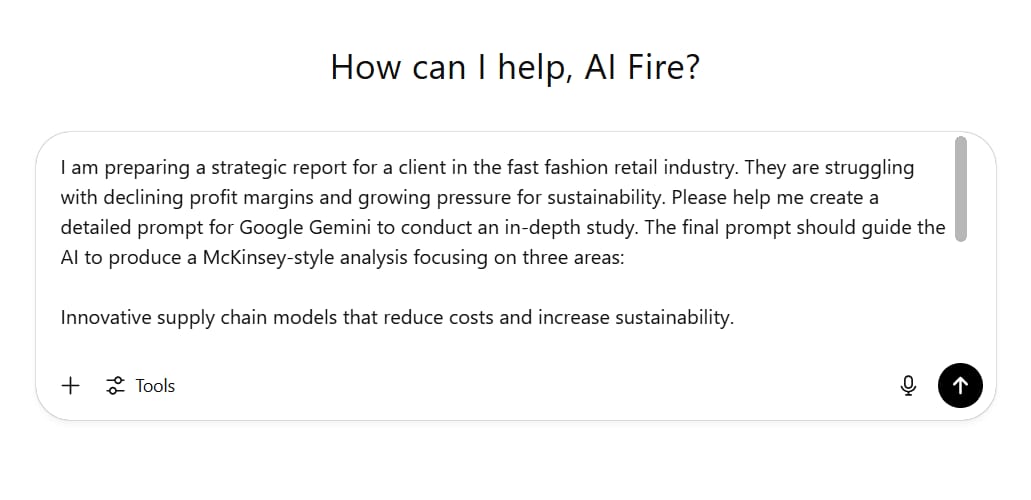
"I am preparing a strategic report for a client in the fast fashion retail industry. They are struggling with declining profit margins and growing pressure for sustainability. Please help me create a detailed prompt for Google Gemini to conduct an in-depth study. The final prompt should guide the AI to produce a McKinsey-style analysis focusing on three areas:
Innovative supply chain models that reduce costs and increase sustainability.
Effective digital marketing strategies to engage Gen Z, who value authenticity and brand ethics.
Emerging technologies (e.g., AI in inventory management, on-demand 3D printing) that could disrupt the current business model.
The output should prioritize case studies with concrete metrics, quantitative market data, and quotes from industry experts."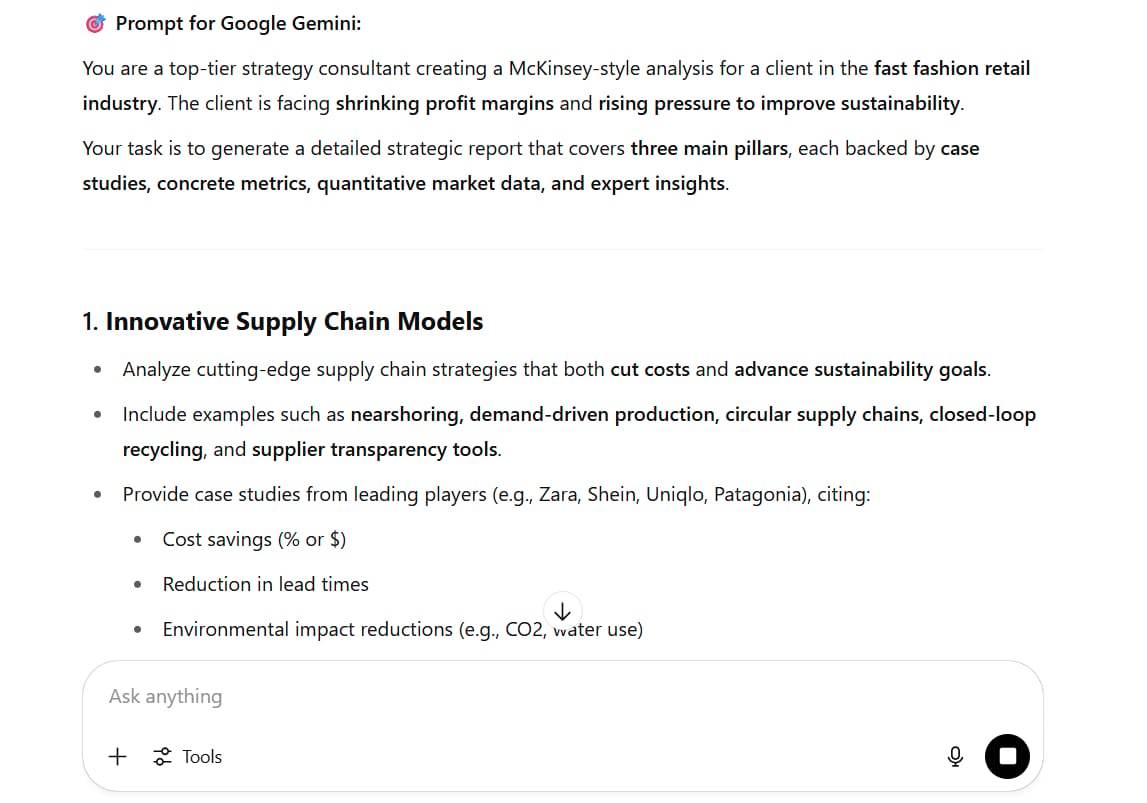
Step 2: Use The Generated Prompt for Deep Research
Take the detailed prompt generated by the meta-prompt and input it into a deep research tool like Google Gemini Advanced. This function will analyze hundreds of sources, synthesize information, and often produce a raw report of 30-100+ pages.
This is a goldmine of information, but no executive will read it. This is where we move to the next stage to distill its value.
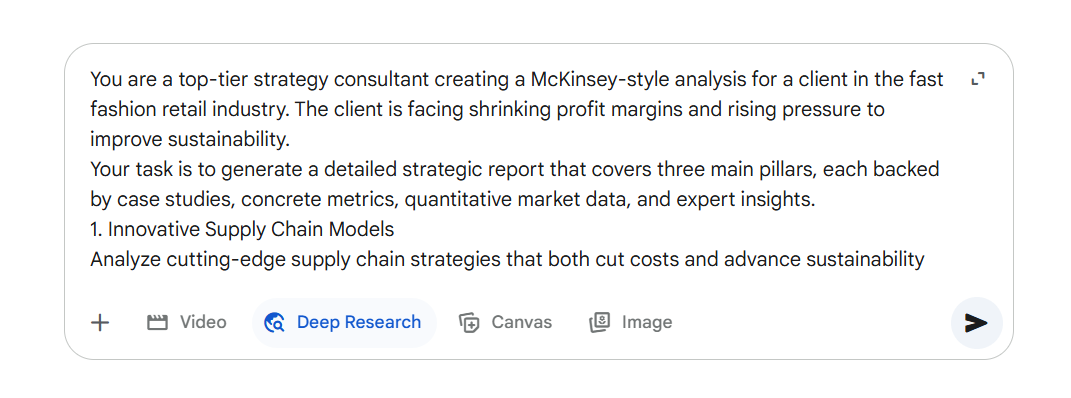
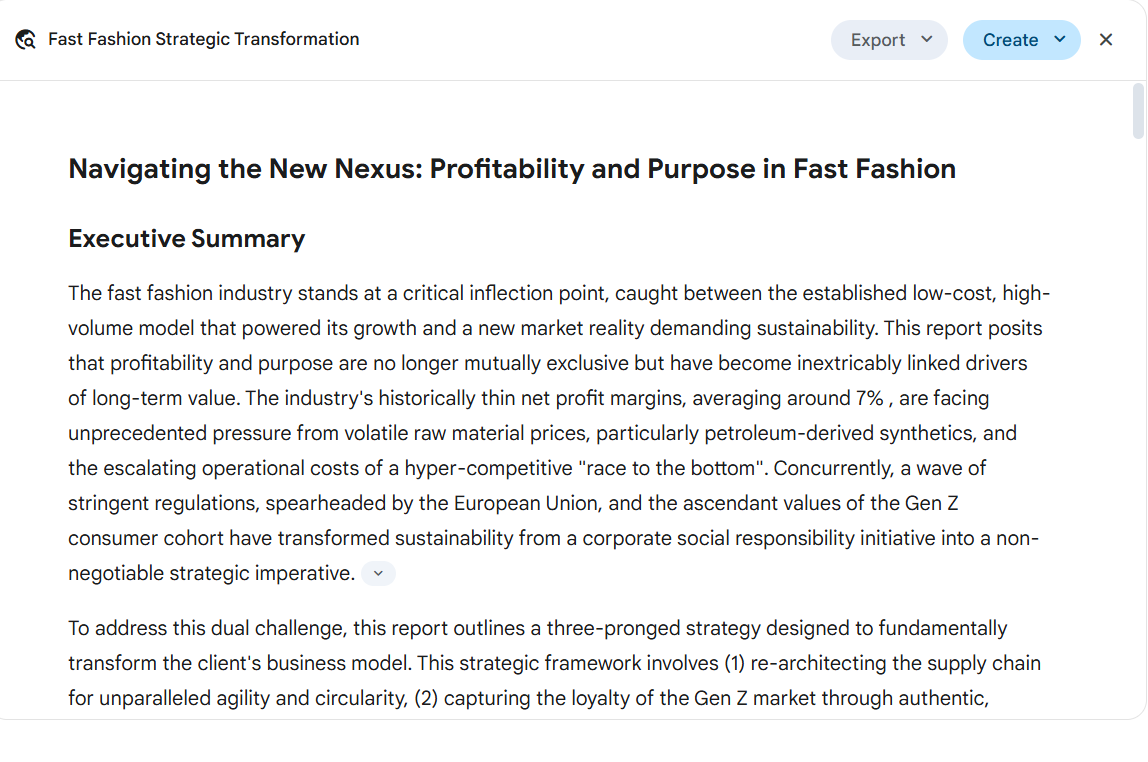
Stage 2: Synthesis – Distilling The Core Message With NotebookLM
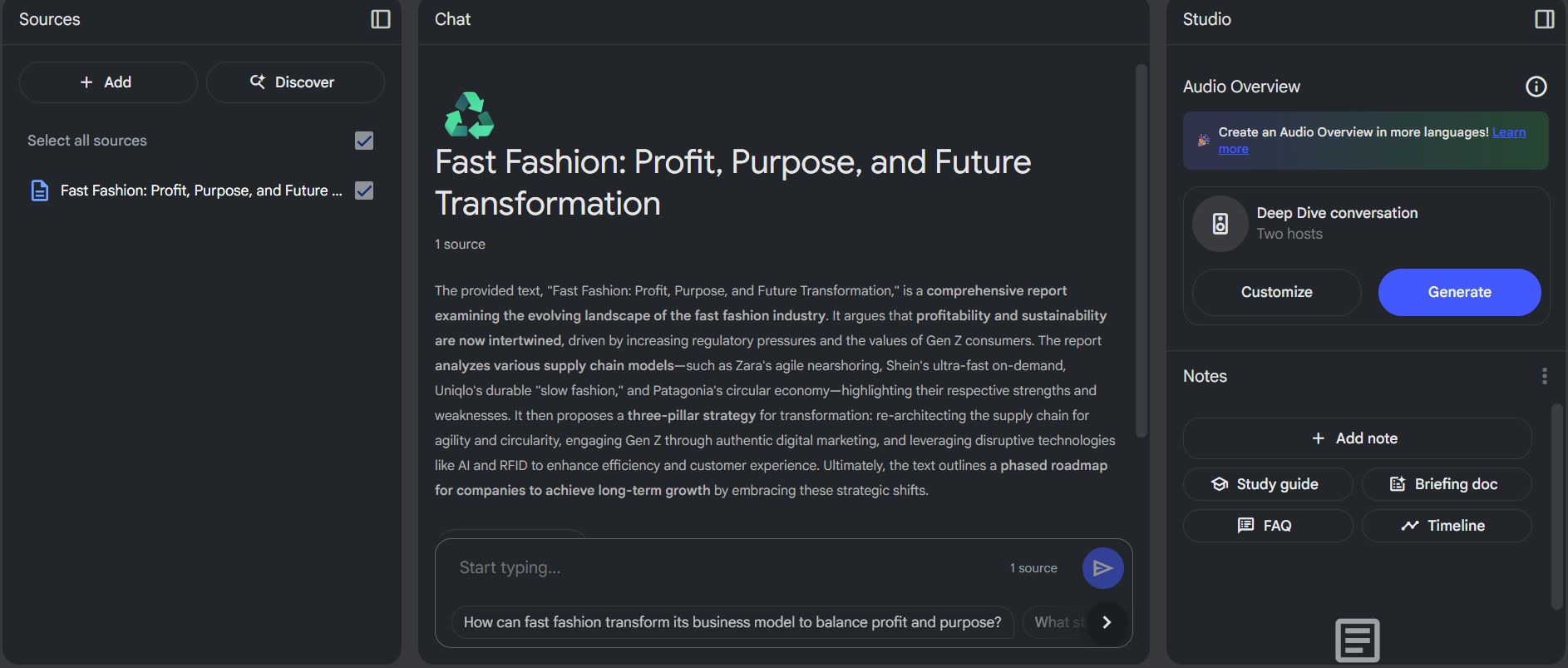
Upload your massive research report to Google NotebookLM. This tool is not a typical language model; it's specifically designed to "talk" to your documents, grounding its answers in the source material you provide.
Step 1: Create a Mind Map
Use NotebookLM's mind map feature to get a visual overview of the main topics and connections within the hundred-page document. This helps you quickly identify key information clusters.

Step 2: Extract the Message with the SCQA Framework
SCQA (Situation, Complication, Question, Answer) is a classic McKinsey framework for structuring the opening of a report. Use the following prompt in NotebookLM:
New Synthesis Prompt Example:
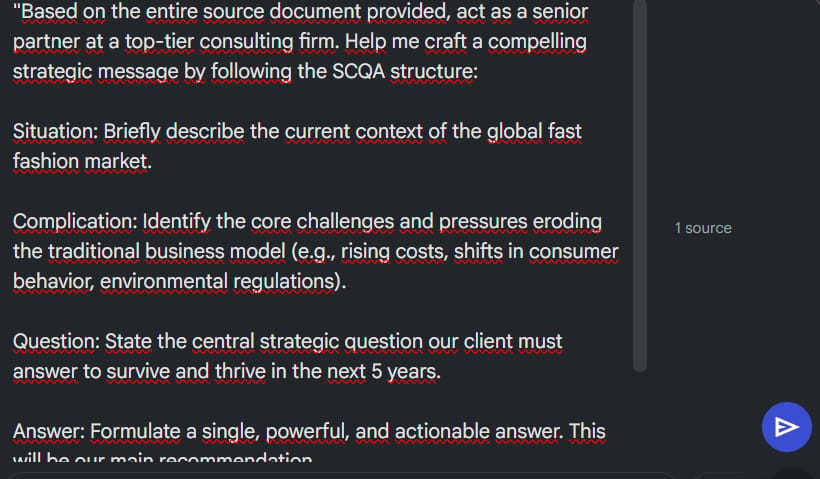
"Based on the entire source document provided, act as a senior partner at a top-tier consulting firm. Help me craft a compelling strategic message by following the SCQA structure:
Situation: Briefly describe the current context of the global fast fashion market.
Complication: Identify the core challenges and pressures eroding the traditional business model (e.g., rising costs, shifts in consumer behavior, environmental regulations).
Question: State the central strategic question our client must answer to survive and thrive in the next 5 years.
Answer: Formulate a single, powerful, and actionable answer. This will be our main recommendation.
Then, propose 3 key supporting arguments that will form the foundation of our report."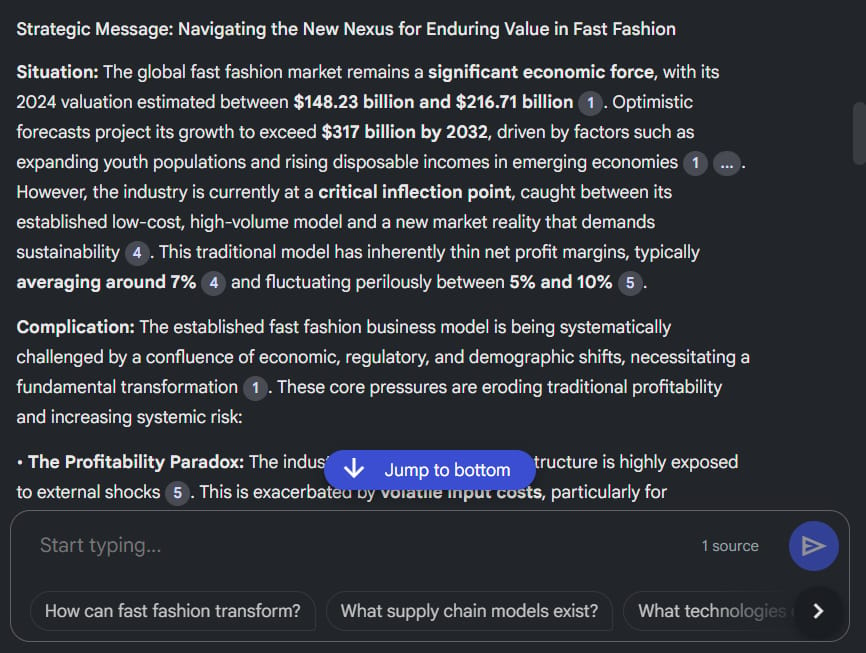
The result of this stage is that you've transformed a 100-page document into a core message that is logically structured and digestible, ready to be built into a pyramid.
Stage 3: Structuring – The MECE Litmus Test
MECE (Mutually Exclusive and Collectively Exhaustive) is another McKinsey gold standard. It ensures that your arguments cover all aspects of the issue without any overlap.
Use AI to stress-test the logic of your argument structure:
New MECE Check Prompt Example:

"Please review the following argument structure for our report:
Main Conclusion: To restore profitability and build a sustainable brand, company ABC must pivot to a 'tech-enabled, on-demand production' model.
Argument 1: Optimizing the supply chain through automation and local suppliers will significantly reduce operational costs.
Argument 2: Building a digital marketing strategy focused on supply chain transparency will attract the Gen Z customer segment.
Argument 3: Investing in predictive data analytics to optimize production and reduce waste.
Please analyze this structure for MECE compliance. Is there any overlap between the arguments (e.g., does 'optimizing production' in argument 3 overlap with 'optimizing the supply chain' in argument 1)? Are there any logical gaps we've missed (e.g., we haven't mentioned the in-store experience)? Suggest ways to refine the arguments so they are truly independent and comprehensive."This stage ensures the logical foundation of your report is rock-solid.
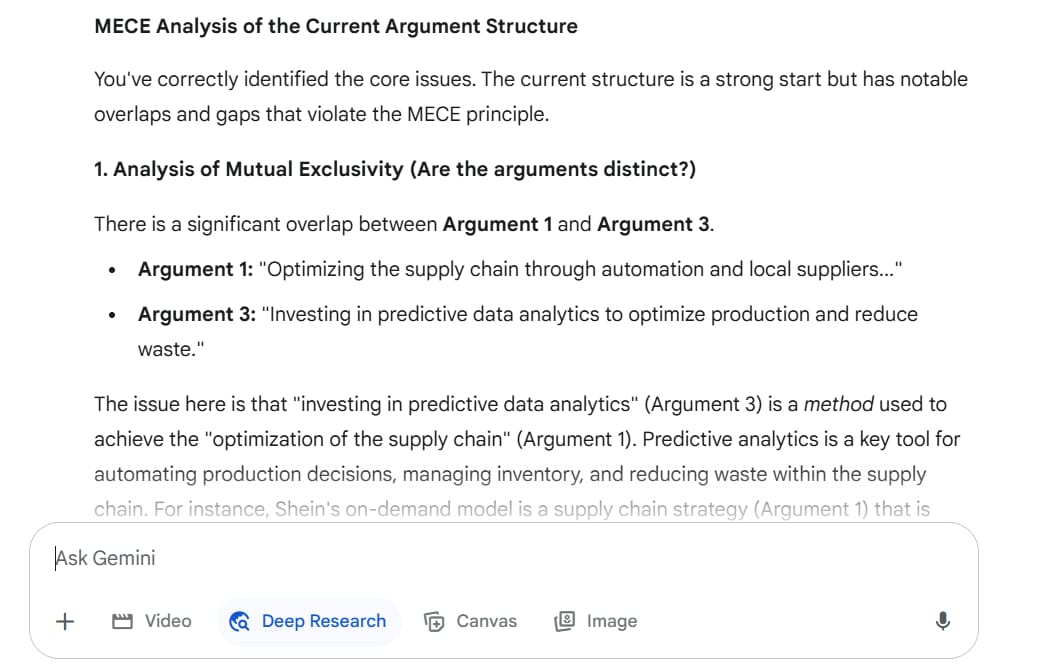
Stage 4: Substantiation - Fortifying Arguments With Evidence
Now it's time to go back to NotebookLM and find the specific proof points to support each of your refined arguments.
New Evidence-Gathering Prompt Example:
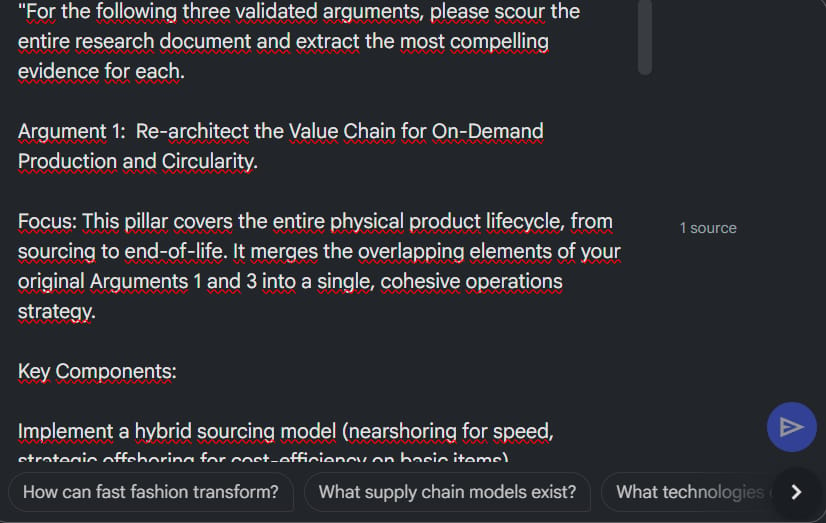
"For the following three validated arguments, please scour the entire research document and extract the most compelling evidence for each.
Argument 1: [Insert refined argument 1]
Argument 2: [Insert refined argument 2]
Argument 3: [Insert refined argument 3]
For each argument, provide:
Quantitative Data: Specific statistics, percentages, financial figures.
Real-World Examples: Case studies of other companies that have implemented similar strategies and the results they achieved.
Expert Quotes: Insights from credible sources within the document.
Source References: Pinpoint the source of each piece of evidence. This is crucial for guarding against 'AI hallucinations' and building credibility."This stage transforms your arguments from mere claims into well-founded, credible assertions.
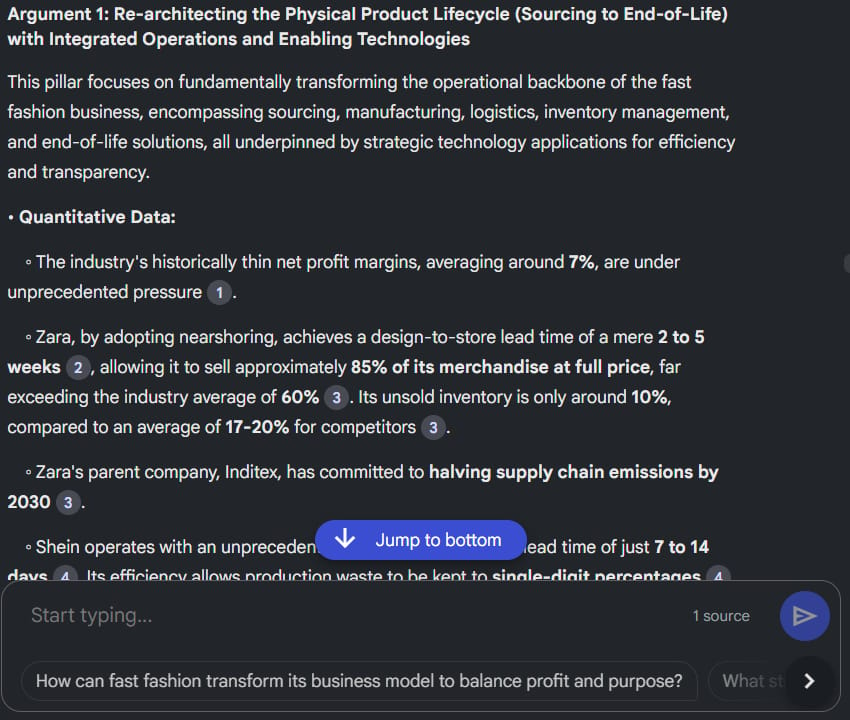
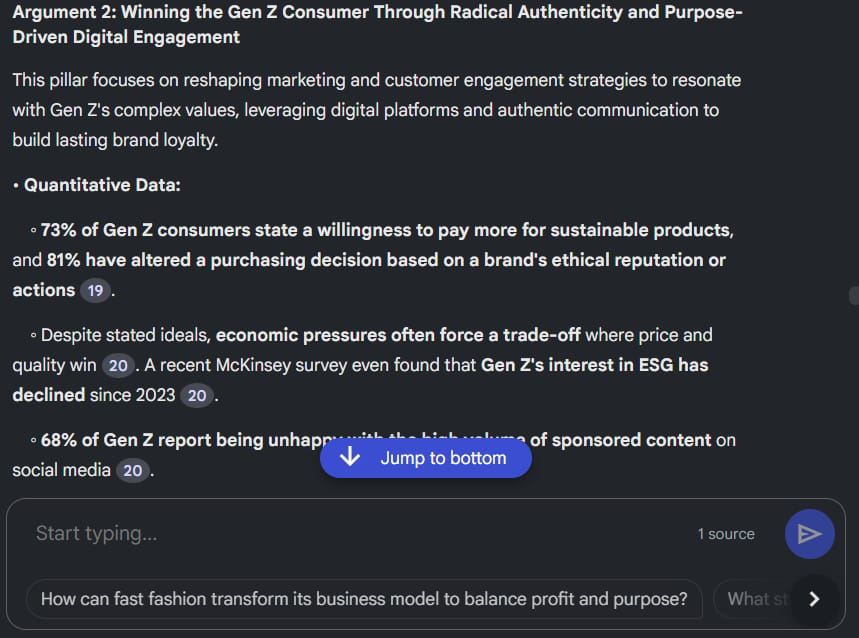
Stage 5: Delivery – Crafting A Persuasive Narrative
Finally, it's time to turn your logical structure and evidence into a compelling presentation. Tools like Gamma.ai are excellent for this, especially with their "paste in text" feature.
Instead of letting Gamma's AI generate content from scratch, feed it the structure you've so carefully built.
New Slide Generation Prompt Example:
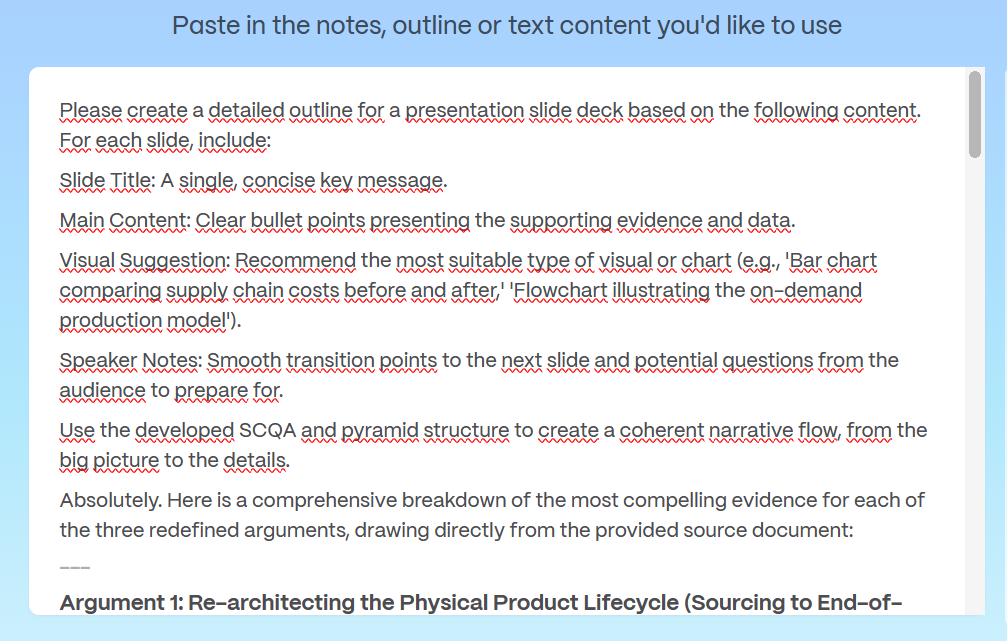
"Please create a detailed outline for a presentation slide deck based on the following content. For each slide, include:
Slide Title: A single, concise key message.
Main Content: Clear bullet points presenting the supporting evidence and data.
Visual Suggestion: Recommend the most suitable type of visual or chart (e.g., 'Bar chart comparing supply chain costs before and after,' 'Flowchart illustrating the on-demand production model').
Speaker Notes: Smooth transition points to the next slide and potential questions from the audience to prepare for.
Use the developed SCQA and pyramid structure to create a coherent narrative flow, from the big picture to the details."Once you have this outline, you can paste it into Gamma.ai. The tool will automatically design professional, beautiful slides while preserving the integrity of your message and logical flow. This gives you the perfect blend of AI-generated design and human-led strategy.
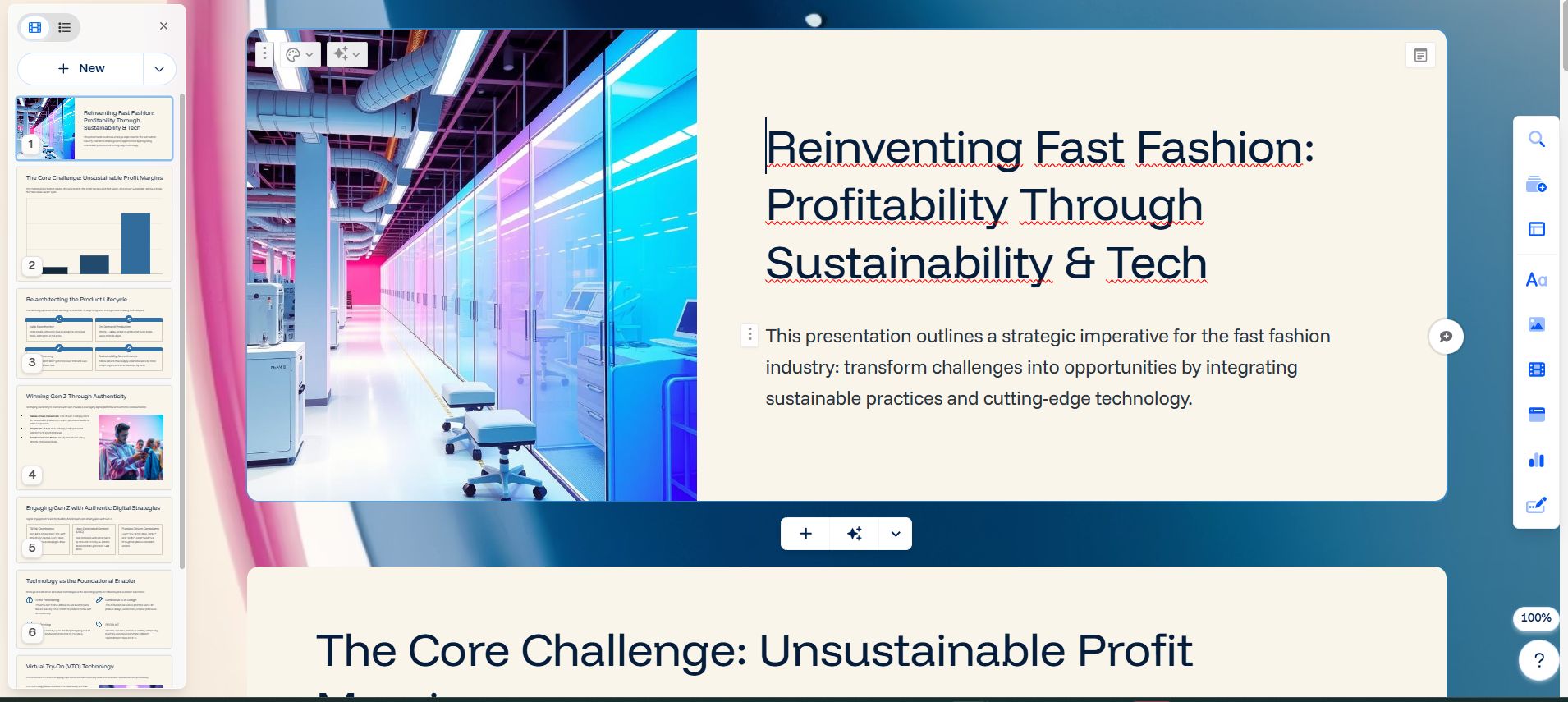
Integrating the Human Element: AI As A Colleague, Not A Replacement
It is critical to emphasize that this system is not intended to eliminate the role of the consultant. On the contrary, it elevates it. The AI does the heavy lifting: large-scale research, initial synthesis, and visual design. This frees up your time and mental energy to focus on what humans do best:

Adding Nuance and Context: An AI may not understand your client's unique corporate culture or internal political dynamics. You can add this layer of analysis to the report.
Building Relationships: No AI can replace a frank, trust-building conversation with a client.
Storytelling: The AI provides the building blocks (data, arguments), but you are the final storyteller who connects the dots and delivers the narrative with conviction and credibility.
View AI as an incredibly talented and tireless junior analyst who prepares all the necessary materials so you can walk into the room and shine as a trusted strategic advisor.
The Modern Consultant's AI Toolkit

To effectively implement this system, here are the core tools you'll need:
Google Gemini (with Advanced plan): Currently the top choice for deep research and generating comprehensive initial analysis.
Google NotebookLM: An indispensable tool for analyzing large documents, synthesizing messages, and extracting sourced evidence.
Gamma.ai: Excellent for rapidly turning structured text into professional presentations.
ChatGPT or Perplexity: Useful alternative tools for research or for cross-checking results from Gemini to mitigate single-model bias.
Most of these tools have free tiers, but for serious consulting work, investing in the paid versions will provide greater capabilities and higher limits.
The Final Mile: From Report To Renewal
The work of a great consultant doesn't end when the final slide is presented. The most critical, and often overlooked, stage is what happens next. This AI-assisted system can help you here as well.
Post-Delivery Communication:

Create an "Implementation Tracking Document": Use prompts to ask the AI to summarize the key action steps, proposed key performance indicators (KPIs), and a projected implementation timeline. Share this document with the client.
Prepare for Questions: Use NotebookLM to generate a "Frequently Asked Questions" (FAQ) list based on your report, helping you anticipate and prepare answers for client concerns.
Follow Up and Support: Schedule regular check-in meetings. In each meeting, demonstrate ongoing value by helping them address implementation hurdles.
This is what separates successful consultants who become long-term partners from those who are merely one-time service providers.
Your Next Steps
If you're ready to revolutionize your consulting approach, start with these concrete actions:
Practice the meta-prompt technique: Choose a topic you know well and try to create a detailed research prompt.
Experiment with NotebookLM: Upload one of your existing reports or documents and see how it can help you summarize and analyze it.
Apply the Pyramid Principle: In your next internal or client presentation, try structuring your message with the conclusion first.
Set up accounts: Sign up for the free versions of the recommended tools to familiarize yourself with their interfaces and capabilities.
Create a workflow template: Based on the 5-stage system, create a personal checklist for future projects.
Final Thoughts
The consulting industry is indeed undergoing a tectonic shift. But this change is not a threat; it's a massive opportunity for those who know how to adapt and leverage it.
By combining time-tested consulting methodologies with cutting-edge AI tools, you can deliver better results, in less time, while dramatically increasing client implementation rates. Ultimately, the transformation lies not just in using AI, but in using AI strategically to solve the industry's oldest problem: bridging the gap between insight and action.
Remember, all the AI tools in the world are useless if you can't get your clients to act on your recommendations. Structure matters. Presentation matters. And most importantly, understanding how your audience makes decisions is paramount. Master this system, and you will not just create reports that impress - you will create reports that transform their businesses.
If you are interested in other topics and how AI is transforming different aspects of our lives or even in making money using AI with more detailed, step-by-step guidance, you can find our other articles here:
The Secret AI System For Endless Viral Videos (Yes, Really!)*
Is The Front End Dead? AI & MCP Are Making It History!*
*indicates a premium content, if any
How useful was this AI tool article for you? 💻Let us know how this article on AI tools helped with your work or learning. Your feedback helps us improve! |
Reply